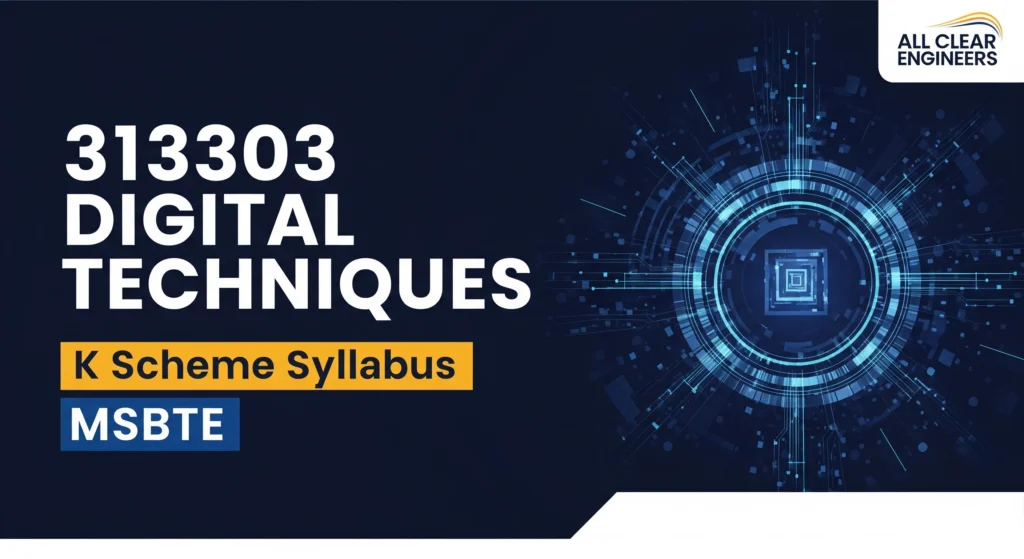Are you a student pursuing a Diploma in Artificial Intelligence under the K program and looking for the latest courses?
You have come to the right place! In this post, we have provided detailed information and free downloadable PDF of 313303 Digital Techniques K scheme syllabus for 2024 academic year.
Students I have also completed my Diploma in Artificial Intelligence. So, I know it was very difficult to find out the syllabus from the official website of Maharashtra State Board of Technical Education.
Stay ahead of your studies by having access to the most up-to-date curriculum, including important topics, course objectives and learning outcomes that are critical to your academic success. Don’t miss out on this treasure!
List of units of Digital Techniques
- Unit – I Number Systems
- Unit – II Logic Gates and Boolean Algebra
- Unit – III Combinational Logic Circuits
- Unit – IV Sequential Logic Circuits
- Unit – V Data Converters and Memories
Unit – I Number Systems
- 1.1 Number Systems: Types of Number Systems (Binary, Octal, Decimal, Hexadecimal), conversion of number systems
- 1.2 Binary Arithemetic: Addition, Subtraction, Multiplication and Division
- 1.3 Subtraction using 1’s and 2’s complement method
- 1.4 Codes: BCD, Gray code, Excess-3 and ASCII code,Code conversions, Applications of codes.
- 1.5 BCD Arithemetic: BCD Addition, Subtraction using 9’s and 10’s complement
Unit – II Logic Gates and Boolean Algebra
- 2.1 Logic Families: Characteristics Parameters of logic Families- Noise margin, Power dissipation, Figure of merit ,Fan in, Fan out, Speed of operation, maximum clock frequency supply voltage requirement ,power per gate , Comparison of TTL, CMOS and ECL logic family
- 2.2 Introduction to positive and negative logic systems, Logic Gates: Symbol ,Truth table of Basic logic gates(AND,OR,NOT),Universal gates(NAND,NOR) and Special purpose gates(EX-OR,EX-NOR)
- 2.3 Buffer: Tristate logic, Unidirectional and Bidirectional
- 2.4 Boolean algebra : Laws of Boolean algebra, Duality Theorem ,De-Morgan’s theorem
Unit – III Combinational Logic Circuits
- 3.1 Standard Boolean expression: Sum of products [SOP] and Products of Sum [POS], Min-term and Max-term, SOP-POS form conversion, realisation using NAND/NOR gates
- 3.2 Boolean Expression reduction using K-map: Minimization of Boolean expressions (upto 4 variables) using SOP and POS form
- 3.3 Arithemetic circuits : design Half and Full Adder using K-maps, design Half and Full Subtractor using K-maps , n bit adder and n bit subtractor .
- 3.4 Encoder and Decoder: Functions of Encoder and Decoder, Block Diagram and Truth table, Priority Encoder (4:2, 8:3), BCD to 7 segment Decoder/Driver, Keyboard Encoder / decoder
- 3.5 Multiplexer and Demultiplexer: Working, Truth table and applications of MUX and DEMUX. MUX tree, DEMUX tree, DEMUX as Decoder
Unit – IV Sequential Logic Circuits
- 4.1 Difference between Combinational and Sequential Logic circuits, Time independent (un-clocked )and Time dependent ( Clocked ) logic system , Flips- Flops and Latch, Basic memory cell ,RS-Latch using NAND and NOR, Triggering methods- Edge trigger and Level Trigger
- 4.2 Flip-Flops: S-R, J-K, T and D, Truth table and logic circuits of each flip-flop, Excitation table, applications
- 4.3 Race around condition in JK flip-flop, Master- Slave JK Flip Flop
- 4.4 Shift registers- Serial In Serial Out, Serial In Parallel Out, Parallel In Serial Out ,Parallel In Parallel Out,Bi-directional Shift register, 4-bit Universal Shift register
- 4.5 Counters- Synchronous and Asynchronous counters, Modulus of counter, Ripple counter, Ring Counter, Twisted Ring Counter, Up – down counter, Decade Counter, MOD-N counter, Timing Diagram
Unit – V Data Converters and Memories
- 5.1 Digital to Analog Data Converter (DAC)- circuit diagram and working of Weighted resistor DAC and R-2R Ladder DAC, DAC Specification/Selection factors
- 5.2 Analog to Digital Data Converter (ADC) : Block Diagram, Types and Working of Dual Slope ADC, Successive Approximation, Flash Type ADC, ADC selection factors/ specifications
- 5.3 Memories: Types- Primary memory , Secondary Memory, Organization, Dimension, Memory Bank, Features , Applications: RAM (SRAM, DRAM), Volatile and Non-Volatile, ROM (PROM, EPROM, EEPROM), Flash Memory, Comparison of RAM and ROM,EPROM and Flash Memory, SIMM: Features, SSD memory: Features,
Laboratory Experiment / Practical Titles / Tutorial Titles
- * Test the functionality of AND, OR, NOT, Ex-OR and EX-NOR logic Gates using equivalent 74 series or CMOS Devices [CD] series.
- * Test the functionality of the given Universal Gates using equivalent 74 series /CD series.
- * Construct Basic Gates using Universal Gates.
- * Construct Basic Gates using Universal Gates.
- * Verify De-Morgan’s Theorem (1 and 2).
- * Implement 2 input, 3 input Adder Circuit.
- Implement 2 input, 3 input Subtractor Circuit.
- Test the output of BCD to 7 Segment Decoder using Digital IC for the given inputs.
- Check the output of comparator circuit consisting of Digital IC.
- * Build and test the functionality of 4:1/8:1 Multiplexer.
- Build and test the functionality of 1:4/1:8 De-Multiplexer.
- Implement and verify the truth table of RS Flip flop.
- Implement and test the functionality of master slave- JK Flip Flop using Digital IC.
- Use Digital IC to construct and test the functionality of D and T flip flop.
- Build 4- bit Universal Shift register and observe the timing diagram.
- Implement Ripple Counter using Digital IC.
- * Implement Decade Counter Using Digital IC.
- * Test the output of given R-2R type Digital to Analog Converter for the given input.





